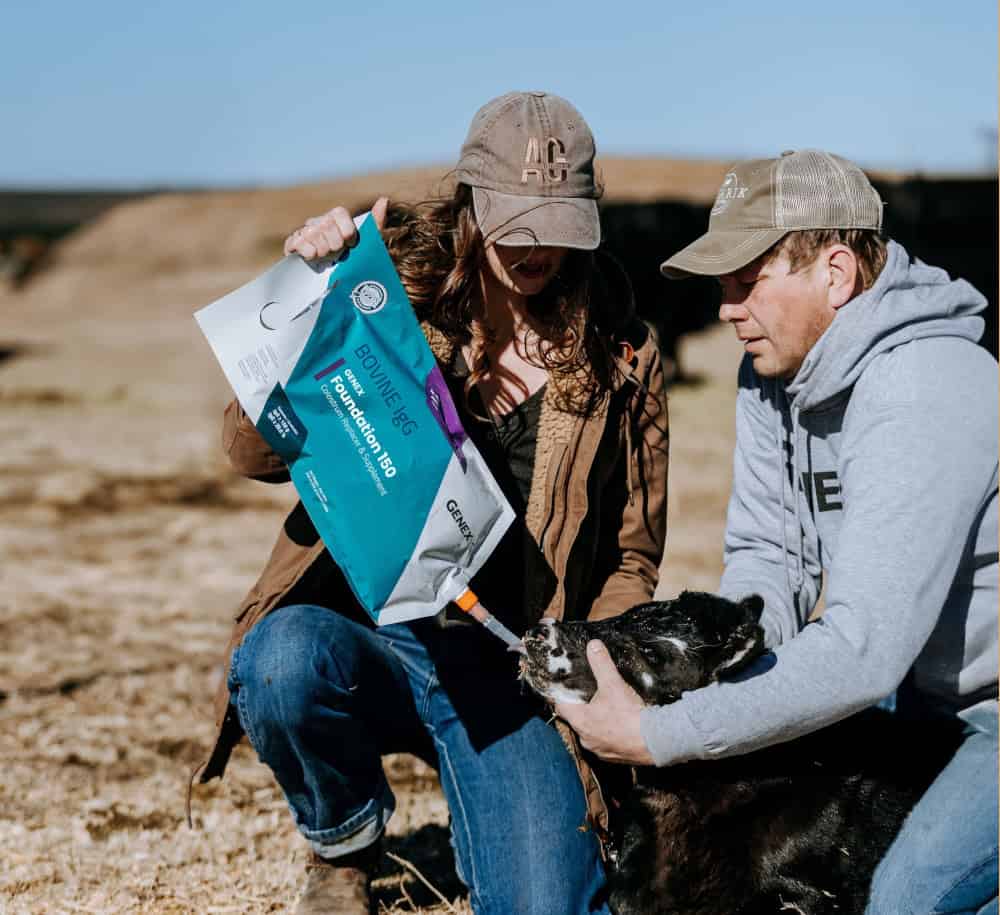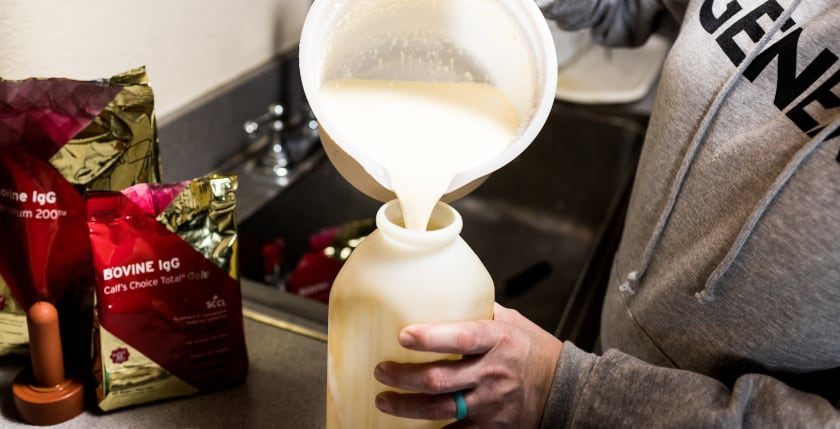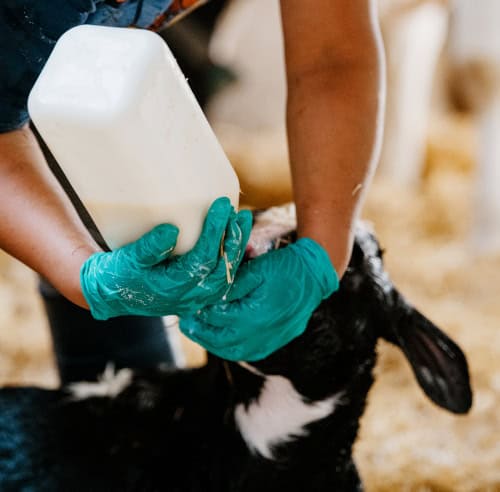The single, most important meal a calf will consume in its life is the first feeding of colostrum. Knowing when and how to intervene are the first steps for ensuring a productive calf.
Here, we answer some of the most frequently asked questions regarding colostrum supplements and replacements in your guide to colostrum feeding.
How can good colostrum feeding practices impact long-term productivity?
The impact of good colostrum feeding practices is often overlooked. Good colostrum feeding practices
and feeding more colostrum can lead to improved average daily gain, reduced treatment costs and better feed conversion efficiency. Improvement in these three areas offers financial benefits to any farm or ranch.
Under what circumstances should calves be fed colostrum?
There are many instances where a colostrum product should be fed to calves. For instance, calves born in very cold weather, twin births, calves born to first-calf heifers and calves born to dams that experienced heat stress. However, calves born with difficulty (also known as dystocia) are at greatest risk for failure of passive transfer of immunity, since they are often slow to get up and suckle. Additionally, these calves’ ability to absorb antibodies may be compromised due to the delay of nursing and altered metabolic parameters.
Whenever calves are born with intervention or assistance, the calf should be given at least a supplement dose of colostrum, if not a full replacement dose. Supplement any calf that has not suckled within 1-2 hours of birth.
When should colostrum be fed?
With each minute that passes after birth, a calf’s ability to absorb antibodies is reduced. By 24 hours the gut is almost completely closed and can no longer absorb antibodies. Therefore, colostrum must be fed as soon as possible after birth, ideally within an hour.
When bottle or tube feeding is necessary (when it is not possible to milk the cow immediately or get the calf up and suckling) a good quality colostrum supplement or replacer is an excellent alternative to ensure the calf receives a timely first meal.
If colostrum has been delayed past 2 hours, feed larger amounts to compensate for reduced absorption.
How much colostrum do calves need?
More is better! Most veterinarians recommend at least 1 gallon (4 liters) of good quality colostrum, providing calves with 200-300g of IgG. This ensures better passive immunity, reducing illness risk. USDA National Animal Health Monitoring System data shows calves with excellent passive transfer of immunity (serum IgG levels of 30 g/L or higher) experience over 10% less illness compared to those with levels at 8 g/L.
Good quality colostrum replacers are ideal when the dam’s colostrum is low in volume or quality, as is often the case with first-calf heifers which may produce less than 1 liter. Their calves, especially, benefit from a colostrum supplement or replacer.
If feeding 300g of a colostrum replacer, it is recommended to divide the colostrum into multiple feedings. Do not feed the entire amount at once.
While absorption slows with each passing hour, calves still benefit from a second and third feeding which adds further immune protection. Increases in immune status have been shown when the second feeding is given even 12 hours after the first feeding.
How should colostrum be fed?
It is important you create colostrum feeding protocols that expedite getting clean, high-quality colostrum to calves within the first 1-2 hours of birth. Colostrum can be administered by bottle feeding or tube feeding. If bottle feeding, do not feed any remainder colostrum in the bottle after the initial feeding. Leaving the remainder sit will add bacterial growth and inoculate the calf’s gut with that bacteria. If the calf does not consume the entire feeding or colostrum is delayed past 6 hours, tube feeding the remainder is suggested in attempt to achieve successful passive transfer of immunity
Should cold weather calves be treated differently?
Calves have a thermal neutral zone of 59 to 77°F (15 to 25°C), and many are born into even colder conditions. Calves need a timely feeding of colostrum to provide energy to produce body heat and warm them. Colostrum contains unique colostral fat that initiates brown fat metabolism. Brown fat metabolism fuels the calf’s internal furnace for heat and energy to get up, suckle, stay warm and stay alive. (Note, bottle-fed colostrum should be warm but not too hot to immerse your hand in.)

Can you use colostrum from your own cows, and if so, how?
Maternal colostrum can be used to supplement calves of other dams, but it must be done right: collect colostrum with sanitized equipment within 2 hours of calving, test colostrum quality with a refractometer, and only use colostrum with 24 Brix or higher. If below this level, enrich the colostrum with whole bovine colostrum powder.
Cool colostrum collected from cows in containers that are 1 liter (1 quart) or less in size. Do it quickly because bacteria counts double every 20 minutes. Store in a refrigerator for up to 48 hours or freeze for up to a year. Avoid repeated freezing and thawing, which can reduce colostrum quality and lifespan.
What should you look for in a colostrum product?
Examine colostrum supplement and replacer ingredient labels carefully. These products can be made from various sources. However, the greatest benefits to the calf result from feeding actual colostrum rather than formulas of proteins and fats from other sources. Products made with whole bovine colostrum contain all the immune, metabolic and growth factors that are naturally found in maternal colostrum.
One very important ingredient is colostral fat. Colostral fat is essential for activating brown fat metabolism, an important energy source required by the calf immediately after birth.
Colostrum products that contain blood or whey with added vegetable and animal fats not naturally found in colostrum do not provide the same benefits for the calf. In fact, some of these products contain no actual colostrum at all.
Look for products that are regulated by the USDA (United States) or CFIA (Canada) and backed by numerous safety and efficacy studies published in scientific journals.
Can colostrum be fed after 24 hours?
Transition milk is produced by the cow for the first six milkings and represents a gradual decline in the bioactive ingredients found in first milk colostrum. Feeding transition milk can be an extra immune booster in addition to its rich composition of nutrients, energy, growth factors and hormones.
While calves can no longer absorb antibodies directly, transition milk still provides local immunity against infections that cause diarrhea. Feeding a colostrum replacement with at least 10g IgG (or 1 cup of first milking maternal colostrum) per feeding is particularly helpful during high-risk periods for scours.
Colostrum customized for your generations
Your farm or ranch operation is unique and so are your requirements for a colostrum product. Yet, no matter your circumstances, there’s a colostrum supplement or replacer product to fit your needs. Browse our line of whole bovine colostrum products.
For product availability outside the USA, please contact your local GENEX retail center or the local GENEX distributor.




